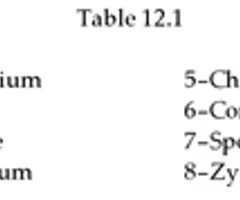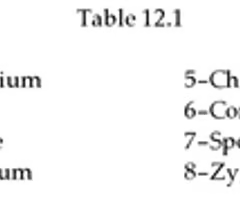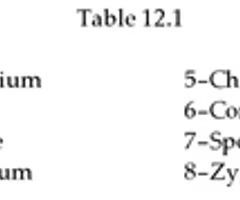CHAPTER 12: FUNGI PROTISTS ALGA HEMILITHS
1/79
Earn XP
Description and Tags
https://quizlet.com/355267349/micro-chapter-12-flash-cards/
Name | Mastery | Learn | Test | Matching | Spaced |
|---|
No study sessions yet.
80 Terms
1) Which of the following statements regarding fungi is FALSE?
A) Most fungi are pathogenic for humans.
B) Fungi are eukaryotic heterotrophs.
C) Fungi reproduce by forming asexual or sexual spores.
D) Most fungi grow well in acidic culture condition.
E) Fungi tolerate low moisture conditions.
A) Most fungi are pathogenic for humans.
2) Which of the following statements about helminths is FALSE?
A) They are heterotrophic.
B) They are multicellular animals.
C) They have eukaryotic cells.
D) All are parasites.
E) Some have male and female reproductive organs in one animal.
D) All are parasites.
3) Which of the following statements about the oomycote algae is FALSE?
A) They form hyphae.
B) They produce zoospores in a sporangium.
C) They cause plant diseases.
D) They have chlorophyll.
E) They reproduce sexually.
D) They have chlorophyll.
4) Seventeen patients in ten hospitals had cutaneous infections caused by Rhizopus. In all seventeen patients, Elastoplast bandages were placed over sterile gauze pads to cover wounds. Fourteen of the patients had surgical wounds, two had venous line insertion sites, and one had a bite wound. Lesions present when the bandages were removed ranged from vesiculopustular eruptions to ulcerations and skin necrosis requiring debridement. Fungi are more likely than bacteria to contaminate bandages because they
A) are aerobic.
B) can tolerate low-moisture conditions.
C) prefer a neutral environment (pH 7).
D) have a fermentative metabolism.
E) cannot tolerate high osmotic pressure.
B) can tolerate low-moisture conditions.
5) Which of the following statements regarding lichens is FALSE?
A) Lichens are a mutualistic relationship between a fungus and a protozoan.
B) Lichens represent a mutualistic relationship between a fungus and an alga.
C) Lichens are often the first life form to colonize rock or soil.
D) The algal partner produces carbohydrates that are absorbed by the fungal partner.
E) The fungal partner provides a means of attachment and protects the algal partner from desiccation.
A) Lichens are a mutualistic relationship between a fungus and a protozoan.
6) Which of the following pairs is mismatched?
A) Basidiomycota — basidiospores
B) Ascomycota — conidiospores
C) Zygomycota — sporangiospores
D) microsporidia — lack mitochondria
E) anamorphs — lack spores
E) anamorphs — lack spores

1-Arthroconidium 5-Chlamydoconidium
2-Ascospore 6-Conidiospore
3-Basidiospore 7-Sporangiospore
4-Blastoconidium 8-Zygospore
7) In Table 12.1, which of these spores are characteristic of Penicillium?
A) 1 and 2
B) 3 and 4
C) 2 and 6
D) 1 and 4
E) 4 and 6
C) 2 and 6

8) In Table 12.1, which of these spores are characteristic of Rhizopus?
A) 1 and 2
B) 6 and 7
C) 2 and 8
D) 1 and 4
E) 7 and 8
E) 7 and 8

9) In Table 12.1, which is a thick-walled spore formed as a segment within a hypha?
A) 1
B) 3
C) 5
D) 7
E) None of the answers is correct.
C) 5

10) In Table 12.1, which of these spores are asexual spores?
A) 1, 4, 5, 6, 7
B) 2, 3, 6, 8
C) 1, 3, 5, 8
D) 2, 4, 6, 7, 8
E) All of the spores are asexual.
A) 1, 4, 5, 6, 7
11) Which of the following pairs is mismatched?
A) teleomorph — produces both sexual and asexual spores
B) dermatomycosis — fungal infection of the skin
C) dimorphic fungus — grows as a yeast or a mold
D) systemic mycosis — fungal infection of body organs
E) coenocytic hyphae — hyphae with cross-walls
E) coenocytic hyphae — hyphae with cross-walls
12) Which of the following statements regarding protozoa is FALSE?
A) Protozoa are unicellular eukaryotes.
B) Nearly all protozoa cause disease.
C) Most protozoa reproduce asexually.
D) Protozoa are common in water and soil.
E) Some protozoan pathogens are transmitted by arthropod vectors.
B) Nearly all protozoa cause disease.
13) In mid-December, a woman with insulin-dependent diabetes who had been on prednisone fell and received an abrasion on the dorsal side of her right hand. She was placed on penicillin. By the end of January, the ulcer had not healed, and she was referred to a plastic surgeon. On January 30, a swab of the wound was cultured at 35°C on blood agar. On the same day, a smear was made for Gram staining. The Gram stain showed large (10 µm) cells. Brownish, waxy colonies grew on the blood agar. Slide cultures set up on February 1 and incubated at 25°C showed septate hyphae and single conidia. The most likely cause of the infection is a
A) gram-negative bacterium.
B) dimorphic fungus.
C) parasitic alga.
D) yeast.
E) protozoan.
B) dimorphic fungus.
14) Which of the following tends to be more complex in a parasitic helminth than in free-living helminths?
A) digestive system
B) nervous system
C) reproductive system
D) digestive and nervous systems
E) digestive, reproductive, and nervous systems
C) reproductive system
15) Which of the following statements is FALSE?
A) Fungi produce sexual spores.
B) Fungi produce asexual spores.
C) Fungal spores are used in identification of fungi.
D) Fungal spores are highly resistant to heat and chemical agents.
E) Fungal spores are for asexual or sexual reproduction.
D) Fungal spores are highly resistant to heat and chemical agents.
16) Which of the following pairs are mismatched?
- arthroconidium — formed by fragmentation
- sporangiospore — formed within hyphae
- conidiospore — formed in a chain
- blastoconidium — formed from a bud
- chlamydoconidium — formed in a sac
A) 1 and 2
B) 2 and 3
C) 2 and 5
D) 3 and 4
E) 4 and 5
C) 2 and 5
17) Which of the following pairs is mismatched?
A) dinoflagellates — paralytic shellfish poisoning
B) brown algae — algin
C) red algae — agar
D) diatoms — petroleum
E) green algae — prokaryotic
E) green algae — prokaryotic
18) Helminthic diseases are usually transmitted to humans by
A) respiratory route.
B) genitourinary route.
C) gastrointestinal route.
D) vectors.
E) aerosols.
C) gastrointestinal route.
19) All of the following are characteristic of the Platyhelminthes EXCEPT that they
A) are hermaphroditic.
B) are dorsoventrally flattened.
C) have highly developed digestive and nervous systems.
D) can be divided into flukes and tapeworms.
E) are multicellular animals.
C) have highly developed digestive and nervous systems.
20) In the malaria parasite life cycle, humans are the host, while mosquitoes are the host as well as the vector.
A) definitive; intermediate
B) intermediate; intermediate
C) temporary; final
D) vector; intermediate
E) intermediate; definitive
E) intermediate; definitive
21) Three weeks after a river rafting trip, three family members experienced symptoms of coughing, fever, and chest pain. During the rafting trip, the family had consumed crayfish that they caught along the river banks. An examination of the patients' sputum revealed helminth eggs, and serum samples were positive for antibodies to Paragonimus. All of the family members recovered following treatment with praziquantel. In the Paragonimus life cycle,
A) the crayfish are the definitive host and humans are the intermediate host.
B) humans are the definitive host and crayfish are the intermediate host.
C) both humans and crayfish are intermediate hosts.
D) both humans and crayfish are definitive hosts.
E) the source of the infection was the river water.
B) humans are the definitive host and crayfish are the intermediate host.
22) The encysted larva of the beef tapeworm is called a
A) redia.
B) cercaria.
C) cysticercus.
D) metacercaria.
E) proglottid.
C) cysticercus.
23) Which of the following arthropods does NOT transmit diseases by sucking blood from a human host?
A) lice
B) fleas
C) houseflies
D) mosquitoes
E) kissing bugs
C) houseflies
24) Which of the following statements about algae is FALSE?
A) They use light as their energy source.
B) They use CO2 as their carbon source.
C) They produce oxygen from hydrolysis of water.
D) All are unicellular.
E) Some are capable of sexual reproduction.
D) All are unicellular.
25) Below are paired items referring to the heartworm Dirofilaria immitis. Which of the pairs is mismatched?
A) dog — definitive host
B) dog — sexual reproduction
C) mosquito — vector
D) mosquito — definitive host
E) None of the pairs is mismatched.
D) mosquito — definitive host
26) All of the following are characteristic of algae EXCEPT which ONE of the following?
A) Most are photoautotrophs.
B) They are currently classified as plants.
C) They may be unicellular or multicellular.
D) Some produce harmful toxins.
E) They mostly live in aquatic habitats.
B) They are currently classified as plants.
27) A definitive host harbors which stage of a parasite?
A) miracidium
B) cyst
C) adult
D) larva
E) All of the answers are correct.
C) adult
28) What do tapeworms eat?
A) intestinal bacteria
B) host tissues
C) red blood cells
D) intestinal contents
E) plant matter
D) intestinal contents
29) Giardia and Trichomonas are unusual eukaryotes because they
A) are motile.
B) lack mitochondria.
C) lack nuclei.
D) do not produce cysts.
E) do produce cysts.
B) lack mitochondria.
30) The life cycle of the fish tapeworm is similar to that of the beef tapeworm. Which of the following is the most effective preventive measure?
A) salting fish before eating
B) refrigerating stored fish
C) cooking fish before eating
D) wearing gloves while handling fish
E) not swimming in fish-infested waters
C) cooking fish before eating
31) Which of the following is the most effective control for malaria?
A) vaccination
B) treating patients
C) eliminate Anopheles mosquitoes
D) eliminate the intermediate host
E) None of these is an effective control.
C) eliminate Anopheles mosquitoes
32) In the microscope, you observe multinucleated amoeboid cells with sporangia that form spores. This is a(n)
A) ascomycete.
B) cellular slime mold.
C) Euglenozoa.
D) tapeworm.
E) plasmodial slime mold.
E) plasmodial slime mold.
33) You observe a mass of amoeba-like cells that swarm together, form a stalk, and produce spores. This is a(n)
A) ascomycete.
B) cellular slime mold.
C) Euglenozoa.
D) tapeworm.
E) plasmodial slime mold.
B) cellular slime mold.
34) Which of the following pairs is mismatched?
A) nematodes — complete digestive tract
B) cestodes — segmented body made of proglottids
C) trematodes — flukes
D) nematodes — many are free-living
E) cestodes — all are free-living
E) cestodes — all are free-living
35) Which of the following is a nucleated, unicellular organism that, if you changed the incubation temperature, would form filaments with conidiospores?
A) ascomycete
B) cellular slime mold
C) euglenozoa
D) tapeworm
E) plasmodial slime mold
A) ascomycete
36) Which of the following organisms is photoautotrophic protozoan?
A) oomycote
B) cellular slime mold
C) Euglena
D) Phytophthora
E) plasmodial slime mold
C) Euglena
37) Which of the following pairs is mismatched?
A) tick — Rocky Mountain spotted fever
B) tick — Lyme disease
C) mosquito — malaria
D) mosquito — Pneumocystis
E) mosquito — encephalitis
D) mosquito — Pneumocystis
38) Which of the following groups of algae does NOT produce compounds that are toxic to humans?
A) diatoms
B) dinoflagellates
C) green algae
D) red algae
E) None of the answers is correct; all of these groups of algae produce compounds toxic to humans.
C) green algae
39) The cells of plasmodial slime molds can grow to several centimeters in diameter because
A) they have organelles.
B) they distribute nutrients by cytoplasmic streaming.
C) the large surface can absorb nutrients.
D) they form spores.
E) they have a mouth to ingest nutrients.
B) they distribute nutrients by cytoplasmic streaming.
40) Assume you have isolated a multicellular heterotrophic organism that produces coenocytic hyphae, motile zoospores, and cellulose cell walls. It is most likely a(n)
A) ascomycete fungus.
B) green alga.
C) oomycote alga.
D) tapeworm.
E) zygomycete fungus.
C) oomycote alga.
41) If a larva of Echinococcus granulosus is found in humans, humans are the
A) definitive host.
B) infected host.
C) intermediate host.
D) reservoir.
E) None of the answers is correct.
C) intermediate host.
42) Ringworm is caused by a(n)
A) fungus.
B) cestode.
C) nematode.
D) protozoan.
E) trematode.
A) fungus.
43) Yeast infections are caused by
A) Aspergillus.
B) Candida albicans.
C) Histoplasma.
D) Penicillium.
E) Saccharomyces cerevisiae.
B) Candida albicans.
44) All of the following are characteristic of lichens EXCEPT
A) they are arranged in foliose, fruticose, or crustose morphologies.
B) they are a major food source for tundra herbivores.
C) they are used as indicators of air pollution.
D) they are a symbiotic relationship between a fungus and a protozoan.
E) they serve as primary producers in rocky ecosystems.
D) they are a symbiotic relationship between a fungus and a protozoan.
45) You see acid-fast oocysts in a fecal sample from a patient who has diarrhea. What is the MOST likely cause?
A) Cryptosporidium
B) diatoms
C) Entamoeba
D) Giardia
E) Taenia
A) Cryptosporidium
1) Plasmogamy, karyogamy, and meiosis are stages of the fungal sexual life cycle.
TRUE
2) Arthropod vectors are blood-sucking animals such as ticks, lice, and fleas that transmit microbial pathogens.
TRUE
3) Cercariae, metacercaria, redia, and sporocysts are all life cycle stages of trematodes.
TRUE
4) The Platyhelminthes group includes roundworms, tapeworms, and flukes.
FALSE
5) Some species of dinoflagellates produce neurotoxins that cause fish kills and red tides.
TRUE
6) Both the cellular slime molds and the plasmodial slime molds are members of the phylum Amoebozoa.
TRUE
7) In helminth life cycles, the organism that harbors the adult sexually reproductive phase of the parasite is called the intermediate host.
FALSE
8) The sporozoite, merozoite, gametocyte, and ring stages are all part of the Plasmodium life cycle.
TRUE
9) The insect vectors have six legs and include spiders, ticks, mosquitoes, and lice.
FALSE
10) Most cases of hookworm infection are acquired by ingestion of adult forms in contaminated food or water.
FALSE
cell mouth in Protozoa
cytosome
Digest food
Vacuole function
Photoautotrophs or facultative chemotrophs; Hemoflagellates (blood parasite)
Disk shaped mitochondria
No sexual reproduction
Trypanosoma brucei- African sleeping sickness
Euglenozoa (phylum)
Excavata (super kingdom)
No mitochondria
Multiple flagella
Giardia lamblia
Intestinal parasites
Diplomonads (phylum)
Super kingdom excavata
No mitochondria
No cyst
Urinary tract
Causes trichomoniasis
Parabasalids (phylum)
Move by pseudopods
Amoebozoa
Amoebozoa
Amoebic dysentery
Transferred by ingestion of cysts
Entamoeba histolytica
Amoebozoa
contact lenses, eats through cornea - blindness
Free living aquatic
Tap water
Acanthamoeba
Amoebozoa
granulomatous amebic encephalitis
Found in freshwater - kid in Florida
Balamuthia
Protozoa acomplexa
Transmitted in feces of cows, dog, rodents, cats
Causes diarrhea
Cryptosporidium
causes malaria
Anopheles mosquito
Merozoites infect red blood cells -ring stage
Plasmodium
A group of protozoans that move by waving tiny, hair-like organelles called cilia.
Free living
Blantidium only human parasite (dysentery)
Most ciliates not parasites
Ciliates
roundworm
dioecious (hermaphroditic) (spicules)
free-living and parasitic
Nematodes
eggs shed in feces then ingested
enterobius vermicularis -pinworm
Nematode (infective eggs)
eggs hatch in soil and larvae enter host via skin
migrate to intestines/lungs
Nematode (infective larvae)
heartworms - spread by mosquitoes
Dirofilaria immitis
Tapeworms
intestinal parasites
scolex - head has suckers
proglottids- body segments - contains male and female
Cestodes
humans are definite host
pork tapeworm
Taenia solium
eggs hatch in intestine travel to liver/lungs
hydatid cyst in liver
Echunococcus grranulosus
flat, leaf shaped
ventral and oral sucker
absorb food through cuticle
Trematodes (flukes)
(flatworms)
- trematoda
- cestoda
platyhelminthes
roundworms
Nematoda
ciliate
causes dysentery
Balantidium coli
causes malaria
apicomplexa
sexual reproduction in anopheles mosquito
Plasmodium
apicomplexa
transmitted in feces of cows, dogs, rodents, cats
Crysptospordium